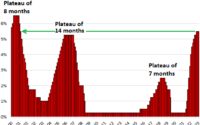US yield curve inversions deepen on hawkish Fed, strong data
By Davide Barbuscia
NEW YORK (Reuters) -Several parts of the U.S. Treasury yield curve are reaching deeper levels of inversion, a sign that bond investors are increasingly worried about an economic slowdown as the Federal Reserve looks set to raise interest rates further.
An inverted yield curve occurs when yields on shorter-dated Treasuries rise above those for longer-term ones, reflecting bets that the central bank will need to cut rates to buoy an economy hurt by higher borrowing costs.
The yield curve’s inversions deepened in June after Fed Chair Jerome Powell indicated that the central bank would likely raise rates two more times this year. Powell on Wednesday reiterated that two more hikes this year were likely, including an increase widely expected next month.
“Keeping rates higher for longer increases the chance that we move into a downturn,” said Janet Rilling, a senior portfolio manager and the head of the Plus Fixed Income team at Allspring Global Investments. “So it is a logical reaction from investors that they would then expect, at some point, that the Fed’s going to have to be more aggressive in cutting.”
Stronger-than-expected economic data on Thursday backed expectations that the Fed will keep interest rates higher for longer. Treasury yields- which move inversely to prices – moved up, with 10-year and two-year yields hitting their highest since March 10 and 9, respectively, while some curve inversions intensified.
Yields on five year Treasuries were as many as 24.5 points above those on 30-year Treasuries on Thursday, the most inverted that portion of the curve has been since March, according to Refinitiv data.
The spread between one- and 30-year Treasury yields was as wide as 153 basis points on Wednesday, its biggest gap since 1981. It narrowed slightly on Thursday to 152 basis points.
And the closely watched part of the curve that plots yields on two-year Treasuries against 10-year yields – a relatively reliable indicator of upcoming recession – inverted further, hitting nearly -107 basis points in intra-day trade on Thursday, close to the -108 bps level it touched before the March banking turmoil, in its turn the deepest since 1981.
That part of the curve has been inverted since July.
“Yield curves inverting … have a very good track record of predicting recessions, but their track record in terms of a timing tool for recession is not so good,” said Huw Roberts, head of Analytics at Quant Insight.
“When it comes to timing, what is more important is the re-steepening of the curve because obviously that is when the Fed is starting to respond to the threat of recession and starts cutting rates,” he said.
The inversions are deepening amid conflicting economic signals. Key areas of the U.S. economy, including housing and labor, have proven resilient despite higher rates.
Data on Thursday showed weekly claims for unemployment insurance fell by the most in 20 months last week, and the final print for first quarter Gross Domestic Product was 2.0%, higher than last month’s 1.3% reading and above expectations.
At the same time, however, signs of stress are piling up.
A recent Fed study showed the number of companies in financial distress was higher than during most previous tightening episodes since the 1970s, concluding that restrictive policies may contribute to a “marked slowdown in investment and employment in the near term.”
(Reporting by Davide Barbuscia; Additional reporting by Chuck Mikolajczak; Editing by Ira Iosebashvili, Sam Holmes, Aurora Ellis and Nick Zieminski)
[ad_2]
Source link


